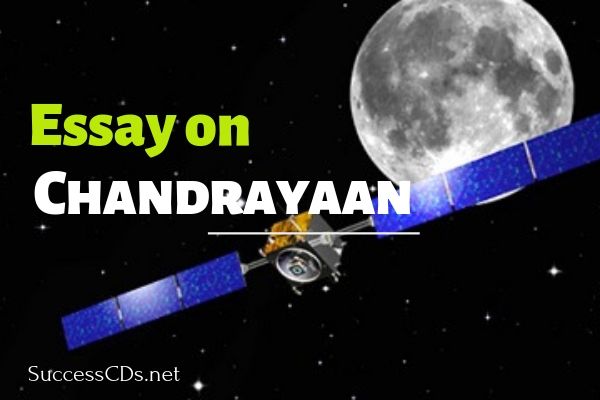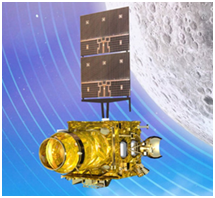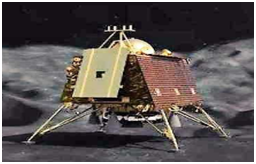By Anurag Chawake

Introduction – This essay on Chandrayaan 2 gives detailed information on the launch of Chandrayaan 2 and chandrayaan 1. Students can take help for preparing article on chandrayaan and can read the article on Indian Space technology for exhaustive information.
The Indian Research Space Organization is undoubtedly one of the world’s most technologically advanced space agencies. Even though its budget is just a fraction of what NASA gets, the space agency has proven that innovative technology can help you achieve the same objectives at a much lower cost.
ISRO’s Chandrayaan mission is one such example. Launched in October of 2008, this is India’s first mission to the moon. The launch of Chandrayaan 1 marked the start of India’s first-ever lunar program.
A Brief about Chandrayaan 1
Chandrayaan 1 was launched on 22 October 2008 from Satish Dhawan Space Centre, Sriharikota. It used the indigenously developed Polar Satellite Launch Vehicle (PSLV-XL) rocket. Chandrayaan 1 was based on an Indian meteorological satellite by the name of Kalpansat.
The spacecraft successfully entered the lunar orbit on 8 November 2008 and just six days later, released its Moon Impact Probe. The Moon Impact Probe crashed near the Shackleton crater on the same day. The Impact Probe crashed in such a way that the subsurface lunar soil could be analyzed for traces of ice.
It carried a total of 11 payloads not only from ISRO but from various space agencies, including NASA, the European Space Agency and the Bulgarian Aerospace Agency.
Hovering just 100 kms above the Moon’s surface, Chandrayaan 1 took numerous high-resolution images of the Moon’s topography. It also performed mineralogical mapping and scoured the surface for any radioactive elements.
One of the mission’s major achievements was the discovery of a large number of water molecules present in the Moon’s soil. The mission cost a mere $56 million and gave us crucial information about the Moon’s surface.
Chandrayaan 1 – Success or failure?
Scientists speculate that frozen water near the Moon’s south pole can be used for a variety of purposes such as generation of rocket fuel, drinking purpose, oxygen generation and to grow plants.
In August 2009, Chandrayaan 1 lost contact with the ground station when it was hovering 200 km above the Moon’s surface. After a while, ISRO officially declared that the mission was over.
Though the probe was expected to last two years, numerous technical issues such as failure of the star sensors and inadequate thermal shielding shortened the lifespan of the spacecraft to just 312 days.
However, 95% of the mission objectives were already achieved. The project was a huge step forward not only for ISRO but also for the world. It paved the way for future lunar explorations.
Following the success of Chandrayaan 1, the way for Chandrayaan 2 was cleared.
Chandrayaan 2
Chandrayaan 2 was launched on July 22 from the same launch pad from which Chandrayaan 1 had taken off. Instead of using the outdated PSLV rocket used earlier, the spacecraft made use of the advanced Geosynchronous Satellite Launch Vehicle Mark III (GSLV Mk III).
The spacecraft is expected to land on the Moon’s on September 7, 2019. According to NASA, the Moon’s polar craters have the Solar System’s lowest temperature. It will be the first probe in the world which will land on the lunar south pole. The main mission objective is the exploration of lunar water near the polar region.
Also, ISRO plans to test the capabilities of its lunar rover named Pragyan. Weighing 27kg, the rover operates on solar power and travels at a speed of 1cm per second. It will continuously perform chemical analysis of the soil and send back to the lander (named Vikram), which will update the ground station.
It is expected that the rover will operate for 14 days but the duration may vary since Pragyan uses solar power to keep itself up.
Unlike last time, ISRO declined to carry any foreign payloads due to weight restrictions. But in June 2019, it agreed to carry a small laser retroreflector from NASA. The orbiter will carry eight payloads, while the lander is carrying three and the rover just two.
However, the orbiter will be hovering over the moon at a distance of 100km and performing passive experiments just like it did on Chandrayaan 1.
Chandrayaan 2 has successfully entered space. That being said, the most critical part will be the auto soft-landing. If the spacecraft lands successfully on the Moon, India will be the fourth country to join the moon club after China, the United States and Russia.
The entire Chandrayaan 2 mission cost approximately $141 million. This is less than every instalment in the Marvel Avenger series.
Unlike Chandrayaan 1, the stakes are pretty high this time since the spacecraft is also carrying a lunar rover, orbiter and a lander. Moreover, Chandrayaan 2 is the country’s first time using self-manufactured components and design vehicles.
The launch is significant for a number of reasons, including the fact that, for the first time in Indian history, a space mission is spearheaded by two women. Chandrayaan-2 is led by Muthayya Vanitha and Ritu Karidhal, the project director and mission director, respectively.
India’s Space Technology at the Global level
Even if the mission ends up in failure, ISRO will have a lot to learn from its experiences, motivating it to do better in the future. India is the only country in the world which successfully completed its maiden interplanetary mission to Mars.
Mangalyaan was launched in 2013 and has completed almost four years in Mars’ orbit. This was a proud moment in the history of the organization since no other space agency has been able to achieve this feat.
It also holds the world record for launching the most satellites in a single mission. Even though ISRO lacks the resources and money compared to what NASA gets, it is continually proving its dominance in the world with its innovative cost-effective solutions.
Currently, with a budget of $1.2 billion, ISRO is ranked at number 5 in the world while having almost a fraction of the budget when compared to other space agencies.
Orbiter, lander and rover of Chandrayaan 2

Orbiter
The orbiter will orbit around the moon at a distance of 100 km. It has been sent with 5 payloads. Three of them are new while the other 2 are the ones that had been sent with Chandrayaan 1. At launch, the orbiter weighed 1400 kgs. The life span of the orbiter is 1 year.
Lander

The lander of Chandrayaan 2 has been named after Indian Space scientist Dr Vikram Sarabhai. It has been designed to work for one lunar day i.e about 14 earth days. Vikram can communicate with the orbiter, rover and the space center too.
Rover

The rover of Chandrayaan 2 weighs 27 kg and works with solar energy. It has been named ‘pragyaan’ which is the Sanskrit word for knowledge. It is a robot vehicle with 6 wheels and can travel upto 500 metres. It can communicate with the lander only. Its aim is to explore the surface of the moon, take samples of the soil and surface, do analysis and send data to the orbiter which will then relay it to the earth.
Success of Chandrayaan 2
The mission has achieved a 95% success with the placement of the orbiter in the moon’s orbit. It will take images of the moon for one year and send the data to earth.
On 7 September 2019, the lander, Vikram tried to make a soft landing on the moon but when it was 2 kms away from the surface, the ISRO lost contant with Vikram. Many efforts have been made to restore communication but the efforts have not been fruitful. The rover has not been able to come out of the lander and thus, it can not gather important information related to the Moon. Due to this, the data that was supposed to be collected by Vikram and pragyaan cannot be collected.
Recommended Read
- Essays in English
- Essay on My Father in English
- Essay on Mahatma Gandhi in English
- Essay on Swami Vivekanand in English
- Essay on Shaheed Bhagat Singh in English
- India’s 15th President Draupadi Murmu, Essay in English
- Essay on Cruelty to Animals in English
- Essay on Importance of English
- Plastic ban – Are we doing enough?
- Essay on my family
- Essay on My best friend
- Essay on Impact of Poverty on Education
- Essay on The Wonder Called Science in English
- Essay on Mobile Phones in English
- Agnipath – A New Recruitment Scheme of Indian Armed Forces
- Role of Technology in Education? English Essay
- What is Exam Result Anxiety and How to Reduce it
- Should Facebook be banned? English Essay
- Suicide Among Students Due to Parental Pressure
- Should selling and using tobacco be banned? English Essay
- Social Media – A cause of Anxiety and Depression
- Should Smoking in Public Places be banned? English Essay
- Essay on Should children get limited access to the Internet?
- Should Education be Free? English Essay
- Coronavirus: Coping With Viruses in the 21st Century: Are we ready?
- To Zoom or Not to Zoom – Is it Safe for Official meetings in 2020?
- Online Education : A Boon or A Curse?
- Citizenship Amendment Act – Confusion and Arguments Explained
- Merger of Banks in India – What are the advantages and disadvantages?
- Essay on why plastic has been banned in India for students
- Impact of COVID-19 on the World Economy
- The Impact of COVID-19 on Global Education and its Solution
- Essay on the importance of Computers in our life
- Essay on Importance of Discipline for success in life
- Essay on Terrorism
- Essay on Skill India Mission
- Essay on Renewable Sources of Energy
- Essay on Make in India Project
- Essay on Haritha Haram Program
- Essay on Corruption
- Ten tips on writing a good essay
- Essay on “My Aim in Life – to become an astronaut”
- Essay on the Importance of Education
- Essay on Beti Bachao, Beti Padhao
- Essay on Importance of sports and games
- Essay on Demonetization
- Essay on Pollution
- Essay on Water conservation
- Essay on Global Warming
- Essay on Diwali in English
- Essay on Holi in English
- Essay on Chandrayaan in English
- Essay on Women Empowerment in English
- Essay on Child labour in English
- Essay on Swachh Bharat Mission
- Contributions of DRDO in Indian Defence